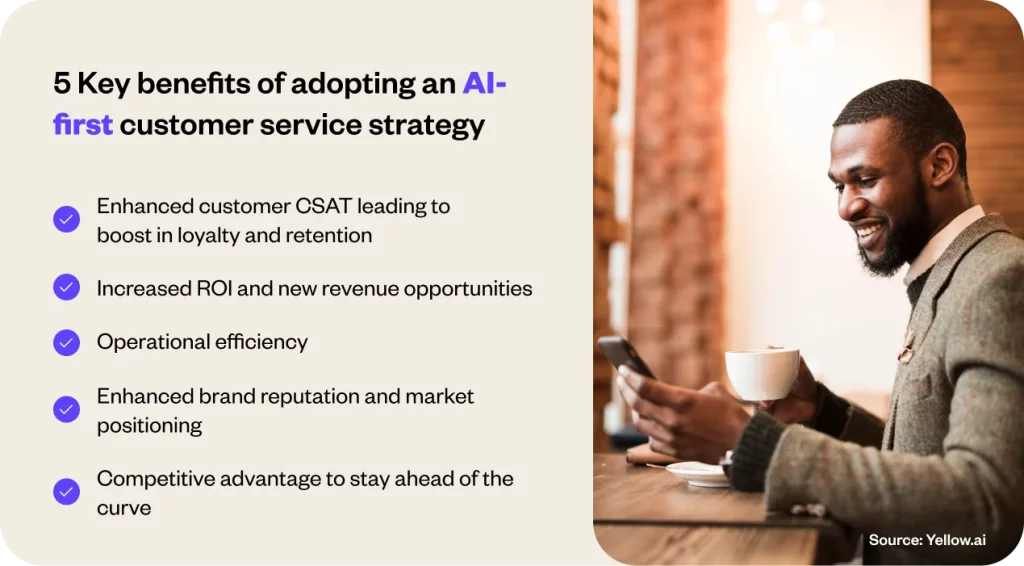In a rush and need the TL/DR version?
Summarize
What is customer service strategy?
A customer service strategy is a detailed roadmap guiding businesses in aligning methods and team capabilities to meet customer needs and achieve organizational goals. It involves proactively enhancing customer experiences and ensuring every interaction is valued.
5 Key benefits of adopting a robust customer service strategy
- Enhanced customer satisfaction and retention
- Increased ROI and new revenue opportunities
- Operational efficiency
- Enhanced brand reputation and market positioning
- Competitive advantage
How to create a robust customer service strategy?
- Define your customer service vision: Align your vision with company values to guide every interaction.
- Build a culture of service excellence: Make customer-centricity a company-wide goal, beyond just the customer service department.
- Craft a detailed customer journey map: Identify touchpoints and friction points to enhance customer engagement.
- Identify metrics that matter and set SMART goals: Focus on meaningful metrics like CSAT, NPS, and CES. Set Specific, Measurable, Achievable, Relevant, and Time-bound goals.
- Develop and retain high-performing agents: Invest in training and tools to empower agents and enhance their skills.
- Leverage technology to optimize customer service: Use AI chatbots and automation for efficient support and data-driven insights.
- Use feedback to fuel improvement: Collect and analyze feedback to continuously refine your strategy.
Harnessing Yellow.ai for your winning customer service strategy
- Sophisticated AI agents: Provide responsive, 24/7 support across multiple channels.
- Empowered self-service: Integrate self-service options for instant customer satisfaction.
- AI copilots for agents: Offer real-time guidance and insights to improve agent efficiency.
- Deep insights for leaders: Use advanced analytics for strategic decision-making and continuous improvement.
- Hyper-personalization: Tailor interactions with deep learning to meet individual customer needs.
Conclusion
Without integrating AI-driven automation, businesses risk falling behind as customer expectations rise. Yellow.ai’s tools provide 24/7 support, self-service options, and personalized interactions, ensuring your customer service strategy is effective and future-ready. Embrace AI to lead the way in exceptional customer service. Book a demo now!
Note: This summary is not a substitute for reading the article in full, as you may miss out on important nuances.
Imagine a scenario where nine out of ten customers keep coming back to you, not just satisfied but eager to experience more of what your brand has to offer. According to a recent Salesforce report, that’s precisely what happens when businesses nail their customer service—91% of customers are more likely to make repeat purchases after a positive experience. While that is super impressive; it also underscores the profound impact stellar customer service can have on a company’s growth and brand loyalty.
Transforming customer service from a functional obligation to a strategic powerhouse is no small feat. It requires vision, commitment, and a deep understanding of what your customers truly need. This blog is your guide through this transformative journey. We’ll delve into the intricacies of creating a customer service strategy, and focus on the complexities of developing a strategy, in customer service and explore how businesses across industries can build and put into action a framework that meets customer needs but also nurtures lasting relationships and loyalty.
Related must-reads:
- 10 Reasons why is customer service important in 2024
- 12 Customer service metrics to measure in 2024
- Should your business outsource customer service?
- 10 Great customer service experience examples in 2024
Fundamentals first: What exactly is a customer service strategy?
It may sound self-explanatory, but a customer service strategy is far more complex and integral to a company’s success than it might initially appear. This strategy serves as a roadmap, guiding businesses in aligning their methods and team capabilities with the dual objectives of fulfilling customer desires and achieving organizational goals. It encompasses every interaction and touchpoint between your business and its customers—not just solving their problems, but actively enhancing their overall experience. It’s about foreseeing potential issues and addressing them proactively to ensure that every customer feels valued and understood.
At its heart, a customer service strategy involves a detailed blueprint that outlines how to meet customer needs, establish service excellence standards, and align these initiatives with the organization’s larger goals. An effective customer service strategy must mirror your brand’s core values and display dedication to customer satisfaction. It must aim to equip every team member, from front-line support staff to top executives, with the tools and mindset needed to deliver consistently exceptional service.
5 Key benefits of adopting a robust customer service strategy
Adopting a robust customer service strategy isn’t just about enhancing day-to-day operations—it’s about realizing significant, long-term benefits that can transform the entire business landscape. This approach goes beyond immediate customer satisfaction to foster a culture of continuous improvement and strategic alignment with overarching business objectives. Here are some benefits of customer service strategy.

1. Enhanced customer CSAT leading to boost in loyalty and retention
“A satisfied customer is the best business strategy of all,” as Michael LeBoeuf, the renowned American business author and management professor, rightly said. Consider the loyalty built by brands like Apple, where exemplary service complements cutting-edge products, encouraging repeat purchases and high customer retention rates. Implementing a robust customer service strategy creates similar brand advocates who not only stay longer but also become vocal proponents of your services. In fact, 27% of customers identify a lack of effectiveness in customer service, and an additional 13% cite a lack of speed, as the primary cause of frustration in customer service.
Related read: How AirAsia empowers employees with gen AI-powered chatbot for seamless self-service
Therefore, a well-defined customer support strategy is essential not just for resolving issues but for doing so in a manner that meets the expectations of promptness and efficiency demanded by today’s customers. This focus on rapid and effective resolution directly contributes to overall customer satisfaction and positions the business as responsive and customer-centric in a competitive marketplace.
2. Increased ROI and new revenue opportunities
Consider a scenario where effective customer service transforms a routine support call into a revenue-generating opportunity. For example, a customer contacting a tech company about a software issue is introduced to a premium support plan that offers faster, more personalized service. This not only resolves their immediate problem but also enhances their overall satisfaction and willingness to invest more in the company’s offerings. Such strategies have been effectively employed by companies like Adobe, where upselling higher-tier services not only increases immediate revenue but also improves long-term ROI by deepening customer engagement and loyalty.
Related read: Customer Retention: 15 Strategies to Improve CR
That’s not all, these loyal customers often become brand advocates. A significant 59% of them are willing to refer a brand to their friends and family, driving up your revenue. This word-of-mouth marketing, facilitated by loyal customers, is invaluable. A customer service strategy that prioritizes exceptional customer experiences at every interaction can cultivate such loyalty, which not only enhances immediate sales but also lays the foundation for a sustainable business model where customer retention becomes a key driver of long-term growth and profitability.
Related read: 10 Key Customer Experience (CX) Trends [2024]
3. Operational efficiency
AI-powered customer service automation transforms operational efficiencies by leveraging multiple channels—voice, chat, and email—to optimize interactions. Take for instance the advanced AI-driven Interactive Voice Response (IVR) systems. These are not your old school touch-tone menus, but smart systems that understand natural language to efficiently direct calls. This sophistication not only curtails the need for constant human oversight but also accelerates the resolution process, dramatically lowering operational costs. Take the example of Waste Connections, where deploying voicebots for routine inquiries led to staggering cost savings of $3.6 million annually!
Then there are AI chatbots, which have become indispensable in managing routine queries on digital platforms like social media and company websites. These bots work round-the-clock, ensuring that customer service doesn’t sleep even when the office does. And let’s not overlook email automation—these tools smartly sift through the avalanche of incoming emails, sorting and tagging them by priority and subject, thus allowing agents to focus on pressing issues that require a personal touch.
Tools like these exemplify how AI can seamlessly integrate into existing platforms, ensuring that every customer concern, whether expressed through a tweet or a detailed email, is directed to the right helpdesk queue without delay.
4. Enhanced brand reputation and market positioning
When your brand consistently exceeds expectations, it doesn’t just meet standards—it sets them. Take Lion Parcel as a prime example. Leveraging Generative AI-powered chatbots provided by Yellow.ai, Lion Parcel has transformed its customer service into a beacon of efficiency and responsiveness within the logistics industry. These dynamic chatbots handle a staggering 85% of customer interactions, enabling instant resolution for a range of queries from tracking deliveries to general customer inquiries, all with minimal human intervention.
This strategic integration of AI not only streamlines operations but also significantly boosts customer satisfaction by offering quick and reliable service across various digital platforms. As a result, Lion Parcel has not only strengthened its position as a leader in customer-centric logistics solutions but has also enhanced its overall brand reputation, underscoring the company’s commitment to innovation and quality service.
5. Competitive advantage to stay ahead of the curve
In today’s fiercely competitive marketplace, exceptional customer service powered by AI can be a distinct advantage that sets your brand apart. For instance, consider how Amazon uses AI to enhance its customer interactions. Their AI systems are designed to anticipate customer needs and provide personalized recommendations and resolutions quickly. This use of technology not only streamlines the process but also significantly improves customer satisfaction and loyalty.
By integrating AI, companies can automate routine inquiries and free up human agents to handle more complex issues, thereby optimizing the overall customer experience. This strategic approach not only sets a high standard within the industry but also transforms typical service encounters into memorable, loyalty-building experiences. Through such innovations, companies can create a competitive edge that attracts and retains customers who value efficiency and personalized service.
Transform your customer service today with Yellow.ai

Game plan for the win: How to create a robust customer service strategy?
While there’s no one-size-fits-all template for customer service strategy as every customer base and needs are different. However certain universal elements can significantly boost your chances of success. This section will explore those key factors to guide you in tailoring a customer service strategy that resonates with your unique business needs and customer base.

1. Define your customer service vision
A successful customer service strategy lies in a clear, aspirational customer service vision. The vision serves as a principle, aligning every team member with your company’s values and mission. It sets the tone for the customer experience you aim to deliver and defines the emotional journey you want your customers to experience.
Related read: Customer service representative: Skills & Strategies
This visionary approach is exemplified by companies like American Express, which strives to be “the world’s most respected service brand,” creating a culture of exceptional service. Nordstrom’s commitment to offering the “most compelling shopping experience possible” and Disney’s goal to “create happiness” are other prime examples. These visions are actionable roadmaps, not just aspirations, guiding every customer interaction and shaping lasting impressions.
To develop your customer service vision, consider the unique aspects of your brand and translate these into your service delivery. The vision should resonate with your core values and set a high standard for customer interactions across all touchpoints. It’s about inspiring your team to deliver experiences that exceed expectations, fostering a culture of excellence, and building enduring customer loyalty.
2. Build a culture of service excellence
Establishing a culture of service excellence starts with making customer-centricity a company-wide goal, transcending beyond just the customer service department. Every department, including IT, accounting, shipping, and marketing, indirectly influences the customer experience. This approach ensures that all employees, regardless of their role, are focused on prioritizing customer needs in their decisions and actions. For example, a marketing manager who thinks of customers first might offer flexible product plans to suit different needs and budgets.
A customer-centric culture is built on the understanding that every customer interaction with the brand, from website engagement to billing inquiries, should leave them feeling valued and satisfied. Hence, it’s vital for every employee, from executives to frontline staff, to understand and contribute towards customer support goals. This involves breaking down silos and fostering cross-departmental communication and collaboration to enhance overall customer service and support.
To reinforce this customer-first approach throughout the organization, it’s effective to use rewards, incentives, and recognition for employees who embody these principles. Celebrating customer-focused achievements with bonuses, company-wide emails, or social media shout-outs not only acknowledges individual contributions but also encourages a collective commitment to exceptional customer service. This strategy not only improves morale but aligns the entire team with the ultimate goal of delivering superior customer service at every point of contact.
3. Craft a detailed customer journey map for improvement
A deep understanding of your customer journey is crucial for enhancing customer service, and a detailed customer journey map is the tool to achieve this. Begin with a basic template and enrich it with data from stakeholder interviews, customer feedback, and purchasing experiences. This enriched map helps identify key touchpoints, emotions, and friction points, guiding improvements in customer engagement and process optimization.
Analyzing customer interactions, especially on social media, is vital in creating a comprehensive map. This map should capture trends, recurring issues, behaviors, and sentiments, which are instrumental in enhancing services, reducing churn, and increasing customer lifetime value. Social media platforms, where customers freely express opinions and concerns, are critical touchpoints for gathering feedback and understanding customer experiences.
Related read: Customer touchpoints – Mapping customer journey and improving CX
Finally, by examining the entire journey from initial engagement through repeat purchases, negative experiences, such as a customer leaving a site post-inquiry, can be analyzed and addressed. This approach helps in rectifying issues that deter purchases, improving service quality, and strengthening customer loyalty, thereby smoothing the customer journey and enhancing overall satisfaction.
4. Identify metrics that matter and set SMART goals
In the quest to improve customer service, it’s easy to get distracted by vanity metrics—impressive numbers that don’t truly reflect your service performance or customer satisfaction. Instead, focus on metrics that matter, such as Customer Satisfaction Score (CSAT), Net Promoter Score (NPS), and Customer Effort Score (CES). These metrics provide genuine insights into customer sentiment and loyalty, guiding you to make impactful changes.
To enhance your customer service strategy effectively, set SMART (Specific, Measurable, Achievable, Relevant, and Time-bound) goals. For instance, aim to improve service levels to 80% by Q4, increase customer reviews by 35% by year-end, or boost employee engagement by 45% by Q4. These targeted objectives provide a clear path to track progress and identify areas for improvement.
Regularly review these goals, adjust your approach as needed, and continually seek new areas for enhancement. By prioritizing meaningful metrics and setting SMART goals, you ensure your customer service strategy drives real, positive outcomes for your business.
5. Develop and retain high-performing customer service agents
Building a high-performing customer support team starts with hiring individuals who possess the right skills and personality for positive customer interactions. Onboarding and training are critical to familiarize them with your standards, processes, and the expectations they need to meet. This training should be an ongoing process, including activities like role-play to enhance communication skills and regular reviews to update approaches and address common issues, and of course empowering them with advanced tools to improve their productivity by leveraging the power of AI goes a long way.
Related read: AI agents: types, benefits, and examples
The training should be tailored to the specific roles within the team, ensuring that each member, from shipping clerks to marketing managers, understands how their role impacts customer experience. Regular feedback, active listening, and considering opinions from those interacting with customers daily are essential. These team members often have invaluable insights into what actions will most please customers and how to preemptively solve potential problems.
When building your team, focus on crucial soft skills like internal motivation, self-awareness, adaptability, empathy, and social skills. Different roles may require different skills; for instance, customer-facing reps should be adept at listening and problem-solving, while managers need strong mentoring and conflict-resolution abilities. Clearly defining these skills for each role, categorizing them as “must-have” or “good to have,” helps in assembling a team equipped to deliver outstanding customer service.
6. Leverage technology to optimize customer service
To optimize customer service, it’s essential to integrate technology like automation, personalization, and analytics into your customer service toolkit. These tools are crucial for gathering data to enhance customer experiences. Post-interaction surveys, for instance, can provide valuable feedback, enabling proactive outreach to dissatisfied customers, improving retention, and fostering loyalty.
Related read: Customer Service Chatbots – Benefits and Examples
Technological solutions such as AI chatbots have become a cornerstone in providing efficient customer support. They offer immediate, round-the-clock assistance for common issues, significantly enhancing the customer experience. Self-service options like chatbots, along with knowledge bases and FAQs, cater to the growing preference of customers to find answers independently. This not only increases customer satisfaction by providing quick solutions but also reduces the volume of direct inquiries, making chatbots one of the most effective tools in modern customer service.
Centralizing these technologies in a single platform streamlines management and analytics, offering a comprehensive view of customer interactions. This integration ensures consistent, high-quality service across all touchpoints and enables customer service agents to provide a more personalized and efficient service, leveraging the insights gained from AI chatbot interactions and other technological tools.
Related read: 9 Real life chatbot examples [well-known brands]
7. Use feedback to fuel customer service improvement
Customer feedback is vital for refining your business, products, and services. Sources like surveys, social media, review websites, and customer service teams provide rich insights. This feedback, particularly from frontline teams who interact directly with customers, highlights areas for improvement. Positive feedback boosts team morale, while constructively addressing negative comments enhances customer relationships, especially when engaged publicly on social media platforms.
Related read: How to improve customer service?
Sharing and utilizing customer feedback across teams is key to evolving your customer service strategy. It should adapt to changing industry trends, customer needs, and business objectives. Exceptional customer service, informed by continuous feedback, sets your brand apart and fosters lifelong brand advocates. With about 64% of Twitter users preferring to engage with brands on social media rather than calling, it’s crucial to be part of these digital conversations.
Incorporating feedback from various channels, including social media and online reviews, offers a comprehensive view of customer sentiments. These platforms are essential for tracking feedback trends and understanding customer preferences. Engaging in these platforms not only shows your commitment to customer care but also provides valuable insights for ongoing strategy refinement and service enhancement.
Harnessing Yellow.ai for a winning customer service strategy
Unlock the potential of customer service with Yellow.ai, where innovation meets practicality. Our platform revolutionizes the interaction landscape by deploying AI-driven solutions that are as smart as they are efficient. With Yellow.ai, your business is equipped with sophisticated tools designed to streamline operations and craft personalized experiences that customers love. Step into the future of service, where every interaction is an opportunity to impress and engage.
1. Sophisticated chat, email and voice AI agents
Yellow.ai deploys cutting-edge text and voice agents that provide responsive, round-the-clock customer support across multiple channels. These AI-driven agents are capable of handling a wide range of customer interactions with consistency and precision, ensuring your service is always accessible.
2. Empowered customers with self-service
Our platform enhances customer autonomy by integrating powerful self-service options. This capability allows customers to resolve many issues on their own, delivering instant satisfaction while efficiently scaling back the load on your service agents.
3. Empowered agent with AI copilots for enhanced support
Yellow.ai’s AI copilots assist your customer service teams by offering real-time guidance, including response suggestions and actionable insights. This support not only boosts the efficiency of your agents but also raises the overall quality of your customer interactions.
4. Empowered customer service leaders with deep insights
Empower your leadership with Yellow.ai’s advanced analytics, which provide a deep dive into customer behaviors and service metrics. These insights are not just data points; they are transformative tools that enable strategic decision-making, helping you refine your approach and continuously elevate your service effectiveness. With this real-time intelligence, your team can proactively adjust strategies, predict customer needs, and ensure that every initiative is aligned with enhancing customer satisfaction and operational efficiency.
5. Hyper-personalization at scale
Yellow.ai redefines personalization through its sophisticated AI capabilities, going beyond surface-level adjustments like names and basic preferences. Our platform harnesses the power of deep learning to analyze extensive customer data, including past interactions, purchase history, and even predictive behavior patterns. This allows Yellow.ai to tailor interactions to an unprecedented degree, adjusting recommendations and responses in real-time to suit individual customer needs and preferences.
Related must- reads:
- A guide on omnichannel customer engagement
- Omnichannel vs multichannel – What’s the difference?
- How Zenyum’s winning omnichannel strategy for CX with Yellow.ai
6. Truly omnichannel experience
With Yellow.ai, your customer service transcends traditional boundaries. Our omnichannel approach ensures continuity and context across all platforms, from social media and email to chat and voice, delivering a unified customer journey.
Read more: The Indispensable Role of AI In Omnichannel Customer Experience
Success stories

Hyundai boosts revenue and improves customer service with AI automation
Explore how Yellow.ai’s automation led to ~1000 car sales, a 10% retail conversion rate, and over 1.4 million user impressions

Pelago reimagines customer experience with generative AI powered conversational AI agents
Within a mere six weeks of going live, Pelago not only onboarded over 5,000 users but also achieved a striking 50% deflection rate!
Conclusion: The power of sustainable customer service strategy
It wouldn’t be an exaggeration to say that today, without integrating AI-driven automation into your customer service strategy, you risk falling behind as customer expectations continue to rise meteorically. Companies that fail to adopt these innovations will find themselves outpaced by those who do. With the right approach and tools, you can set your brand apart in a crowded market, turning every customer interaction into a building block for a stronger, more resilient brand.
By incorporating platforms like Yellow.ai, you can provide around-the-clock support, ensuring that your customers always receive prompt and accurate assistance. Self-service options empower your customers to resolve issues on their own terms, while AI copilots assist your agents with real-time insights and suggestions, making every interaction more effective. Hyper-personalization, driven by deep data analysis, ensures that each customer feels uniquely valued, while comprehensive analytics provide the insights needed for continuous improvement. These tools are not just enhancements—they are necessities for any business committed to excellence in customer service.
The future of customer service is here—make sure your business is ready to lead the way, with Yellow.ai. Book a demo now!
Frequently asked questions (FAQs)
Why is a customer service strategy important for a business?
Importance of Customer Service Strategy for Business
- Retain customers
- Builds customer loyalty
- Enhances customer satisfaction
- Competitive advantage
- Corporate culture
- Customer service reflects your brand
- Improved customer service
- Increases customer lifetime value
- Employee retention
- Generates referrals
- Happy customers will refer others
- Increased sales
What are the key elements of a customer service strategy?
The Key Elements of Customer Service
- A company-wide mission
- A recruitment process to hire the right people
- A commitment to ongoing training
- A customer service policy
- A focus on empowering your team
- An effective feedback loop
How can I measure the success of my customer service strategy?
A high FCR is linked to increased satisfaction, so it’s a critical metric in customer service. The formula for working out your FCR is simple. Take the number of incidents resolved in the first contact, and divide by the total number of incidents. Then, times this number by 100.
What role does technology play in a customer service strategy?
A major function that technology covers for customer service is automating standard processes between customer service agents and their customers and effectively saving time and resources for businesses and helping customers get answers to common queries and problems faster.
How can I ensure my customer service strategy is customer-centric?
To achieve better customer-centricity, here are five best practices to help your business stand out:
- Hire for customer success
- Put relationships first
- Democratize customer data
- Connect company culture to customer outcomes
- Define your CX strategy

















